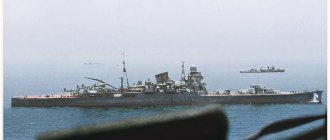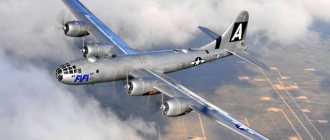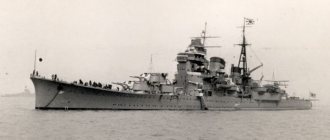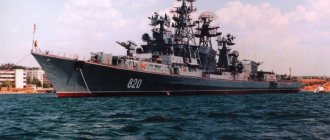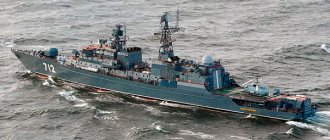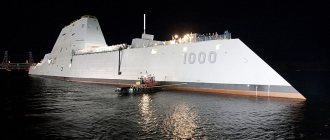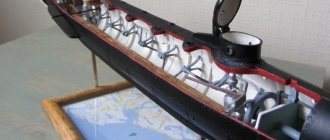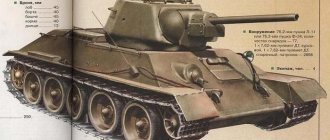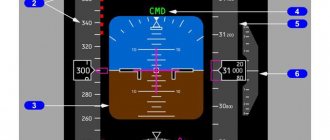Z-52
A versatile destroyer done right.
Pros:
German GAP (5.9/4km).
2/3 of the towers face forward - you can use this.
Torpedoes charge quickly (1.5 minutes versus 2 for everyone except Shima).
Great BB damage.
Minuses:
Weak torpedoes.
Bad ballistics.
The air defenses are knocked out.
The most similar ship is Giering/Meuse.
The German-10 also has good air defense, but without a barrier. He gets knocked out, but that's not his main advantage.
The Z-52 perfectly kills destroyers in smoke - it sees them at almost 6 km. While other German destroyers have a much shorter GAP. His German smokes become quite usable by level 10, while the American ones are too long to provide a significant advantage. It can quite successfully pursue other destroyers, because it still has speed, afterburner, and ballistics are not as bad as those of the Amers.
And as soon as the Z-52 kills the enemy destroyers (which is almost a victory), it can begin to win back the torpedo destroyer - even though there are only 8 torpedoes, this is even a plus - you can throw them more often, and hope more for flooding than for direct damage. And then you can enjoy the spectacle of blazing opponents from the smoke.
Nice top, worth the download.
So what happened:
There are 2 unique ships, both good - Shima and Khabarovsk. There are 3 generalists, among them a good one is the Z-52, because it can use its own gun placement, and its feature is not air defense, but the detection of other destroyers. And it was even more pleasant for me to use torpedoes on it than on Grozovoy or Giering.
What could save Grozovoy/Gearing?
Grozovoy - reverse damage attack from universals, so that you can always count on air defense.
Gieringu - short radar. The radar could also have saved Grozovoy, but perhaps that would have made him too tough, and his unique role is, after all, an air defense destroyer. But this also depends on the Aviks, and they will do something with them. It is not yet clear what.
Author of the publication
offline 2 years
Links
1919—1945 Caldwell · Vicks · Clemson · Farragut · Porter · Mahan · Gridley · Bagley · Somers · Benham · Sims · Benson · Gleaves · "Bristol" · "Fletcher" · "Allen M. Sumner" · "Robert H. Smith" · " Gearing " 1916—1959 (Escorts) Eagle · Evarts · Cannon · Edsell · Buckley · Raddyrow · John Butler · Dealy · Claude Jones after 1945 Mitscher · Forrest Sherman · Kunz · Charles F. Adams · Lehi · Spruance · Kidd · Arleigh Burke · Zumwalt Light aircraft carriers "Independence" · "Saipan" W Escort carriers Long Island · Bogue E · Sangamon · Avenger · Casablanca · Commencement Bay Battleships Wyoming · New York · Nevada · Pennsylvania · New Mexico · Tennessee · Colorado · North Carolina · South Dakota · Iowa · Montana Battlecruisers "Alaska" Heavy cruisers Pensacola · Northampton · Portland · New Orleans · Wichita E · Baltimore · Oregon City W · Des Moines W Light cruisers Omaha · Brooklyn · Atlanta · Cleveland · Fargo W · Worcester W Destroyers Vicks · Clemson · Farragut · Porter · Mahan · Gridley · Bagley · Somers · Benham · Sims · Benson · Gleaves · Bristol " · "Fletcher" · "Allen M. Sumner" · "Robert H. Smith" · " Gearing " Escort destroyers Evarts · Buckley · Cannon · Edsall · Rudderow · John C. Butler Patrol frigates Asheville · Tacoma Minesweepers Lapwing · Raven · Auk · EagleS · Hawk · Admirable Submarines O · R · S · Barracuda · ArgonautЕ · Narwhal · DolphinЕ · Cachalot · Porpoise · Salmon · Sargo · Tambor · Mackerel · Gato · Balao · Tench E - the only ship in the series W - completed after the war O - construction canceled
Shimakaze
Weeboo should pump up Shima, if only because it's Shima-chan. But others might like it too.
pros:
Quite extraordinary - she cooks torpedo soup better than anyone else (besides her, only Shiratsuya can make the same density, but 2 times less often).
The fastest torpedoes in the game are 76 knots.
Changing torpedoes allows you to choose between different play styles - two styles for the price of one.
After the torpedo stealth upgrade, she became a very good destroyer.
Fast.
Minuses:
Stock torpedoes suck.
Assume that there is no air defense - even one fighter of the 7th level will be shot down.
Art is of little use.
The most similar ship is Shiratsuyu.
In general, if you want to pump up destroyer-10 and like to sink armored tanks with torpedoes, Shima is the best choice. It is quite comfortable to play on it after you learn it, and it is very different from the previous Yugumo - there are twice as many torpedoes, and the speed is higher.
While there are few Aviks in battles at this level, Shima is doing well enough.
German destroyer Narvik: in battle with common sense
Continuing the series about the most useless ships.
The high characteristics of German technology allow us to close our eyes to many of its shortcomings. Many, except one.
How were those “high performance” achieved? The answer is unlikely to please even the most staunch supporters of German engineering. The increase in selected characteristics among the Germans was always achieved either at the cost of a critical deterioration in the remaining performance characteristics, or contained some hidden “nuances”. Of course, these restrictions become known at the very last moment.
This was especially evident during the war years. The voluntarism of the command and the strange decisions of the developers cost the Wehrmacht and the Kriegsmarine big problems.
How can you disrespect your sailors in order to accept Narvik-class destroyers?
“The power of fire rages within me!”
Indeed, the Zerstorer type 1936A surpassed all known destroyers in artillery power. But their overall combat effectiveness was in doubt. Why? For destroyers built 1930-1940. A five-inch caliber was considered optimal. In practice, there was a spread of ±0.3 inches, and a variety of systems were hidden under similar values. For example, British 120 mm (4.7”) naval guns, known for their mass production, simplicity and compactness. The weight of a single-gun installation is within 9 tons, a two-gun installation is 23 tons.
The Americans have short-barreled 127 mm Mk.12 guns. Their relatively light projectile (25 kg) and mediocre ballistics were compensated by “nimble” guidance drives and an unexpectedly high rate of fire. The weight of a single-gun installation on destroyers is 14 tons, and a two-gun installation is from 34 to 43 tons. Large mass indicators are a consequence of the presence of powerful drives and automated reloading at barrel elevation angles of more than 80°.
The most powerful among the naval "five-inch" guns were considered to be Soviet 130 mm caliber guns, whose shells (33 kg) stood out for their power. The Soviet Union did not have many ships, and there was nowhere to wait for help from the destroyers. A powerful weapon with good ballistics was required. The weight of the B-13 single-gun installation is 12.8 tons.
The 130-mm two-gun turret installation B-2LM already weighed 49 tons, of which 42 tons were in the rotating part. The increase in mass is a direct consequence of the automation of the recharging process. Such massive artillery systems were not used on wartime destroyers; Only the leader of “Tashkent” managed to receive them.
When it came to the Germans, their answer was the destroyer Narvik with a “cruising” main caliber.
The very name of the 15 cm Torpedobootkannone C/36 guns sounded enchanting. A six-inch caliber gun for destroyers!
The mass and caliber of the projectile are related by a cubic relationship
When the caliber increases from 130 to 150 mm, the mass of the projectile increases by 1.5 times.
However, the artillery system itself becomes heavier. Primarily due to the automation of the loading process necessary for such a caliber. Manually moving 50 kg ammunition even in the absence of motion becomes problematic. The dimensions of elevators and conveyors are increasing. The mass of the turntable, all drives and mechanisms increases sharply. The simplest turret with a pair of six-inch guns weighed 91 tons
.
We are talking about the British Mark XXI with 6”/50 guns for light cruisers of the Linder and Arethusa type (early 30s). The cruiser turrets had nominal anti-fragmentation armor (25 mm), and the bulk of their mass was on the platform with guns and ammunition supply mechanisms mounted on it.
The 6” caliber 1-gun mounts also had an impressive weight. For example, the 150-mm MPL C/28 installation of the cruiser Deutschland weighed 25 tons.
At this point the introduction ends and the criticism begins.
Dear sirs, even though you are not specialists at Deutsch Schiff und Maschinenbau, what is your opinion? What problems did the Nazis have to face in creating a destroyer armed with five cruiser-caliber guns?
First and obvious: this is technically impossible.
With the indicated difference in the mass of 5- and 6-inch artillery systems, the destroyer will simply capsize from the prohibitive “upper weight”.
Of course, if we are talking about full 6”. But what if...
The true caliber of the German six-inch guns was 149.1 mm, and their shells weighed 5 kg less than their British counterparts. The differences are small enough to matter in combat. On the other hand, they did not lead to a significant reduction in the mass of the artillery system.
The technology did not tolerate abuse. But it was possible to get even on the sailors!
Manual feeding of six-inch ammunition, even in the absence of pitching, icy wind and lashing streams of water, was not an easy task... But not for real ubermensch!
Why massive transporters and electrically driven rammers? Let the Germans feed the shells with their hands. With your hands!
The weight of a two-gun turret with anti-fragmentation protection, in the absence of mechanization, was reduced to 60 tons.
The single-gun weighed 16 tons. Of course, when placing the gun in a shielded box installation, open to all winds, the process of manually reloading 45-kg shells took a little longer than it was calculated.
The firepower of the Narviks depended entirely on weather conditions and the endurance of the loaders.
It turned out to be insignificant in real combat conditions. Nobody expected this!
1943
The gray veil of the December storm was broken by two silhouettes: the light cruisers Glasgow and Enterprise. The task is to intercept a detected enemy formation in the Bay of Biscay. Unlike the modern Glasgow, which was armed with twelve 152 mm automated guns, the Enterprise was an outdated Scout, having only five 152 mm guns, where the shells were fed manually. In this sense, it corresponded to the destroyer Narvik. There were five of them on the horizon, accompanied by six destroyers!
17 six-inch guns versus 24 German ones. 22 torpedo tubes versus 76. Don’t forget about the support from Elbing-class destroyers. The 1,700-ton ships could not conduct artillery combat in stormy weather, but they actively maneuvered and set up smoke screens, “diverting” part of the fire from the Glasgow and the Enterprise. At this time, a German long-range bomber launched an attack on the cruisers...
It would seem that everything is over. “Glasgow” alone, with the vague support of his partner, will not survive this battle.
Over the next 3 hours, His Majesty's ship Glasgow killed everyone who was within the range of its guns. German losses included the flagship destroyer Z-27, two destroyers and 400 men. their crews. In response, Narvik managed to score a single hit against Glasgow. The Germans were saved only by fleeing in different directions - their squadron was scattered along the entire coast of France.
The battle between the Z-26 and the light cruiser Trinidad ended with a similar result, which was then continued by the destroyer Eclipse, which wedged in at the end of the battle. The German super-destroyer sank, also failing to cause noticeable damage to the enemy with its weapons.
Another feat of the Narviks was the battle with the funeral procession in the Norwegian Sea. Then the cruiser Edinburgh, with its stern torn off, was attacked by British destroyers in tow.
A day before the events described, the cruiser was hit by two torpedoes fired by the submarine U-456. Edinburgh lost control and was practically unable to move under its own power. All that remains of the ship is its White Ensign battle flag, gunnery computer station and weapons.
The destroyer Hermann Schoeman, which ventured to approach, was destroyed by the second salvo. The two remaining "Narvik" (Z-24 and Z-25) hastily left the battlefield, frightened by the shots of the uncontrollable and sinking "Edinburgh" and its two "tugboats" - the British destroyers "Forrester" and "Forsythe". Each of which was 1.5 times smaller than the Narvik, and almost twice as large in the mass of the salvo.
The Germans failed to create any super-destroyer capable of taking on the tasks of a light cruiser.
According to military experts, such unsatisfactory results have a simple explanation.
In any sea conditions and other things being equal, the cruiser has always been a more stable artillery platform. He could shoot more accurately and further.
The cruiser was superior to the destroyer in terms of freeboard, which was important in an era when combat posts were located on the upper deck.
The cruiser had superior fire control capabilities.
Dimensions and displacement of light cruisers of the 30-40s. made it possible to install full-fledged closed towers on them, providing more or less comfortable conditions for the crews to work. The thickness of the tower walls provided minimal anti-fragmentation protection. And the technical level of the 30s made it possible to forget about manual placement and delivery of shells of this caliber.
The Germans knew about all the shortcomings associated with placing heavy weapons on ships of inappropriate size even before the Narvikov was laid down. The destroyer Z8 Bruno Heinemann was the first to receive the 15 cm TBK C/36 gun as an experiment. The results turned out to be negative; seaworthiness and stability caused serious concerns among sailors. The Bruno Heinemann was quickly returned to its original armament of five 128 mm guns.
Apparently, the unsuccessful experience with the Z8 was not enough, so the Germans laid down a whole series of 15 destroyers of the 1936A and 1936A (Mob) types.
And “Narviki” showed themselves in all their glory. This number of failures led to a return to the traditional five-inch caliber (the subsequent type 1936B). But the idea of a “super destroyer” still did not leave the Kriegsmarine leadership. There, a proposal was considered to build a “bicaliber” modification of the 1936B with the replacement of two 128 mm bow guns with a single 150 mm caliber. However, common sense prevailed. The complexity of fire control of two different calibers made such a project futile.
It remains to add that the choice of a caliber disproportionate for a destroyer completely deprived the Narvik artillery of its versatility. It was practically impossible to conduct defensive anti-aircraft fire from main caliber guns with barrel elevation angles of 30°.
But this is just a small fly in the ointment.
Continuation of the weight disaster
Even having made the artillery as light as possible, it was not possible to completely cope with the excess weight.
No intensive methods worked, so the extensive path remained. Increasing the size of the ship itself.
When talking about the destroyer Narvik, you need to understand that by European standards it was not exactly a destroyer. Its total displacement exceeded 3,500 tons. For comparison: the total displacement of the “Stalinist seven”, the destroyer Project 7 “Gnevny”, was 2000 tons. The total displacement of the modernized 7-U Storozhevoy is about 2300 tons. British destroyers, for example, HMS Zealous (the future Israeli Eilat), had approximately the same values - 2500 tons.
The American “Fletchers”, built to fit the size of the Pacific Ocean, are not an indicator here. But even they were inferior in size to the German “overgrown”.
Narvik turned out to be unexpectedly large, complex and expensive
for operations in European waters. It was precisely this kind of project that the German industry, which was experiencing an eternal lack of resources, lacked.
On average, 1000 tons more displacement than competitors.
The crew is larger by 100 people.
A power plant with a power of up to 75 thousand hp, in size and cost very close to the power plant of cruisers.
It is worth noting that due to the overweight bow and associated specific seaworthiness, most Narviks could not even come close to the calculated values of 36-37 knots. In practice, 33 knots was considered normal. Only destroyers with a reduced number of weapons (instead of a bow turret, one single-gun installation with a box-shaped shield) developed somewhat higher speeds.
As for the quality of the power plant itself, this is evidenced by a simple fact. According to the Naval War Command (Oberkommando der Marine, OKM), during the war, every fourth German destroyer stood at the wall of a ship repair yard with dismantled boilers. This has never been observed in any of the fleets.
The reason is high-pressure Wagner boilers with a working pressure of 70 atmospheres. For comparison: the operating pressure in the boilers of the Gnevny-class destroyers was 26 atm.
A classic case for German engines and power plants. Insane afterburner, high specific performance at the cost of a merciless accident rate.
In terms of fuel consumption and cruising range, German destroyers, despite their size, were also inferior to most of their rivals.
The only advantage of the Narvik power plant was its high automation: the staff of the shift consisted of 3 mechanics, whose work stations were equipped with electric cigarette lighters. Undoubtedly the most useful element on board a warship.
On the other hand, a malfunction in the automation led to a complete loss of speed. The Germans did not wait for the advent of electronics, relying on unreliable and vulnerable analog control and monitoring devices.
Despite the described convenience of combat posts, the conditions for housing personnel were terrible. Crowded accommodation in cockpits, three-tier hammocks, lack of living space. This was explained by the lack of need for long trips to sea. Most of the time, the crews of German destroyers lived on mother ships or in barracks on shore.
There must be at least something good in this hopeless darkness of the mind?
Without a doubt!
"Narviki" carried the largest number of 20- and 37-mm anti-aircraft guns among all the destroyers of European countries. However, this is not surprising given their size.
Another absolute success was the quality of the fire and water drainage systems, which traditionally had a high priority on German ships. Their operation in emergency mode was ensured by four backup diesel generators located in the hull and superstructure. And the six main water pumps had a capacity of 540 tons of water per hour!
Even after receiving serious injuries and losing speed and combat effectiveness, Narvik continued to stubbornly mark the enemy’s radars. We had to shoot again and again to “finish off” the wounded man.
However, some of them were lucky. For example, the Z-34, which was seriously damaged by Soviet torpedo boats. Despite the complete destruction of the engine room, that "Narvik" held out until the arrival of the Schnellbot formation and with their help reached Swinemünde.
In general, the experience of creating a destroyer with “cruising” artillery was considered negative by the Germans themselves, who were forced to return to the construction of destroyers with traditional weapons.
The dimensions of the Zerstorer did not allow all the benefits of switching to a larger caliber to be realized, and a very high price had to be paid for this
15 of the 40 German destroyers that took part in the war were essentially ships of limited combat capability.
And the superiority in offensive power declared for them went unnoticed by the enemy. Having touched on the topic of “Narviks”, it is impossible not to mention their theoretical rivals.
If they were not the prototype and primary goal of the German super-destroyers, then, in any case, they contributed to the development of the idea of a destroyer with powerful artillery.
We are talking about French counter-destroyers, in domestic terminology - the leaders of the destroyers “Vauquelin”, “Mogador”, “Le Fantask”...
The largest in size is the 4,000-ton beauty Mogador, which was capable of developing 39 knots in calm water. Armed with eight (!) twin 138 mm caliber guns, whose shells weighed more than 40 kg. To the credit of the French, they managed to achieve combined loading, in which an automatic projectile rammer was used at barrel elevation angles of no more than 10°. After which it was necessary to manually feed a relatively light cartridge case with gunpowder. The mass of an open two-gun installation with a box-shaped shield was 35 tons.
If the Germans really saw Mogador as a threat and an object to emulate, then this is evidence of the “competence” of the Kriegsmarine leadership. Despite its external brilliance and splendor, the Mogador turned out to be a meaningless project, all of whose tasks were reduced to those of conventional destroyers with more traditional sizes and armament. With a disproportionate difference in the cost of their construction.
For its intended purpose (conducting reconnaissance for a squadron of high-speed battleships), the Mogador was even more useless than for artillery combat. All large ships at that time already had catapults with reconnaissance aircraft on board. There was no need for a high-speed reconnaissance ship.
In the 1930-1940s. Not a single attempt to create a special class of warships with a displacement of 3.5-4 thousand tons was successful in practice. The destroyer remained a destroyer.
To radically increase combat capabilities, it was necessary to add several thousand tons of displacement, which automatically transferred the project to the class of light cruisers. No successful intermediate options were found.
It has already been said about the French counter-destroyers.
The American Gearings and Sumners spent their entire displacement reserves on anti-aircraft guns and ensuring autonomy for operations on the endless ocean. They could not boast of either speed or a significant increase in artillery weapons (high-quality universal guns, but nothing more). Actually, they have nothing to do with it at all. These are ordinary destroyers of the Pacific theater of war.
“Tashkent,” despite its “noble” origin and excellent speed qualities, remained under-armed for its size.
But it’s better to be under-armed than what happened to the Germans. All of the listed ships were superior to Narvik in terms of overall performance characteristics and combat capabilities.
